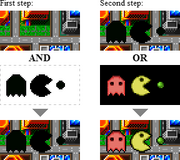In computer graphics, when a given image is intended to be placed over a background, the transparent areas can be specified through a binary mask. This way, for each intended image there are actually two bitmaps: the actual image, in which the unused areas are given a pixel value with all bits set to 0s, and an additional mask, in which the correspondent image areas are given a pixel value of all bits set to 0s and the surrounding areas a value of all bits set to 1s. In the sample at right, black pixels have the all-zero bits and white pixels have the all-one bits.
At run time, to put the image on the screen over the background, the program first masks the screen pixel's bits with the image mask at the desired coordinates using the bitwise AND operation. This preserves the background pixels of the transparent areas while resets with zeros the bits of the pixels which will be obscured by the overlapped image.
Then, the program renders the image pixel's bits by combining them with the background pixel's bits using the bitwise OR operation. This way, the image pixels are appropriately placed while keeping the background surrounding pixels preserved. The result is a perfect compound of the image over the background.

Example of image mask
This technique is used for painting pointing device cursors, in typical 2-D videogames for characters, bullets and so on (the sprites), for GUI icons, and for video titling and other image mixing applications.
Although related (due to being used for the same purposes), transparent colors and alpha channels are techniques which do not involve the image pixel mixage by binary masking.
